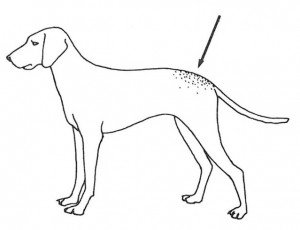
The symptoms of cheyletiellosis are not so specific, that the fur mite bites can be diagnosed from the skin symptoms alone. Experiments have been carried out in which people allowed themselves to be bidden under controlled conditions, however, the results only showed that the reactions of the tested people varied significantly.
Bite marks. When a fur mite bites a person for the very first time, s small red spot may appear on the skin. It is not swollen, only 2-4 mm and usually disappears in a matter of hours. If the bites are repeated, the reaction is intensified. The spot no longer disappears. A small clear blister appears in the middle and the surrounding skin is hard and swollen. However, the most important symptom is severe itching in the bite wounds. Secondarily, scratching a hole may cause infection of the wound. Bide marks from this species are similar in appearance to the skin reactions you get after contact with, for example, the hair of the larder beetle larva. However, larder beetle hairs and the like usually leave a dark spot in the centre of the wound and the clear blister can be infected (yellow) after a few days.
Location of the bites. Fur mites can penetrate clothes and the biting usually occurs where the first contact with the body is made. These are the places on the body which have had physical contact with the host animal. Typical bites locations include arms, chest, abdomen, and thighs.
When sharing a bed with the host animal, there are several options. Bites on the buttocks do not mean that you have sat on a cat or dog. It is rather caused by, for example, sitting on a chair on which the infected dog or cat has just been. Be aware that itch mites (pseudo scabies) can be found in the same locations.




